Baler
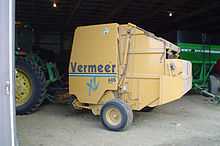
A baler is a piece of farm machinery used to compress a cut and raked crop (such as hay, cotton, straw, or silage) into compact bales that are easy to handle, transport, and store. Several different types of balers are commonly used, each producing a different type of bales – rectangular or cylindrical, of various sizes, bound with twine, strapping, netting, or wire.
Industrial balers are also used in material recycling facilities, primarily for baling metal, plastic, or paper for transport.
History
Before the 19th century, hay was cut by hand and most typically stored in haystacks. In the 1860s mechanical cutting devices were developed; from these came the modern devices including mechanical mowers and balers. In 1872 a reaper that used a knotter device to bundle and bind hay was invented by Charles Withington; this was commercialized in 1874 by Cyrus McCormick.[1] In 1936, Innes invented an automatic baler that tied bales with twine using Appleby-type knotters from a John Deere grain binder; an improved version patented by Ed Nolt in 1939 was more reliable and became commonly used.[1]
Round baler

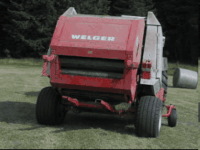
The most common type of baler in industrialized countries today is the large round baler. It produces cylinder-shaped "round" or "rolled" bales. The design has a "thatched roof" effect that withstands weather well.[2]Grass is rolled up inside the baler using rubberized belts, fixed rollers, or a combination of the two. When the bale reaches a predetermined size, either netting or twine is wrapped around it to hold its shape. The back of the baler swings open, and the bale is discharged. The bales are complete at this stage, but they may also be wrapped in plastic sheeting by a bale wrapper, either to keep hay dry when stored outside or convert damp grass into silage. Variable-chamber balers typically produce bales from 48 to 72 inches (120 to 180 cm) in diameter and up to 60 inches (150 cm) in width. The bales can weigh anywhere from 1,100 to 2,200 pounds (500 to 1,000 kg), depending upon size, material, and moisture content.
Originally conceived by Ummo Luebbens circa 1910, the first round baler did not see production until 1947 when Allis-Chalmers introduced the Roto-Baler. Marketed for the water-shedding and light weight properties of its hay bales, AC had sold nearly 70,000 units by the end of production in 1960.[3] The next major innovation began in 1965 when a graduate student at Iowa State University, Virgil Haverdink, sought out Wesley F. Buchele, a professor of Agricultural Engineering, seeking a research topic for a master thesis.[4][2] Over the next year Buchele and Haverdink developed a new design for a large round baler, completed and tested in 1966, and thereafter dubbed the Buchele-Haverdink large round baler.[2] The large round bales were about 5 ft in diameter, 7 ft long, and they weighed about 600 lb after they dried—about 5 lb/[ft.sup.3].[5] The design was promoted as a "Whale of a Bale" and Iowa State University now explains the innovative design as follows:
"Farmers were saved from the backbreaking chore of slinging hay bales in the 1960s when Iowa State agricultural engineering professor Wesley Buchele and a group of student researchers invented a baler that produced large, round bales that could be moved by tractor. The baler has become the predominant forage-handling machine in the United States."[6]
In the summer of 1969, the Australian Econ Fodder Roller baler came out, a design that made a 300-lb ground-rolled bale. In September of that same year The Hawkbilt Company of Vinton, Iowa, contacted Dr. Buchele about his design, then fabricated a large ground-rolling round baler which baled hay that had been laid out in a windrow, and began manufacturing large round balers in 1970.[5] In 1972, Gary Vermeer of Pella, Iowa, designed and fabricated a round baler after the design of the A-C Roto-Baler, and the Vermeer Company began selling its model 605 - the first modern round baler. The Vermeer design used belts to compact hay into a cylindrical shape as is seen today.[7] In the early 1980s, collaboration between Walterscheid and Vermeer produced the first effective uses of CV joints in balers, and later in other farm machinery. Due to the heavy torque required for such equipment, double Cardan joints are primarily used. Former Walterscheid engineer Martin Brown is credited with "inventing" this use for universal joints.
By 1975, fifteen American and Canadian companies were manufacturing large round balers.[5]
Round bale handling and transport

Round bales can weigh a ton or more, and are well-suited for modern large scale farming operations such as a dairy with 200 or more cows. However, due to the ability for a round bale to roll away on a slope, they require special transport and moving equipment.
The most important tool for round bale handling is the bale spear or spike, which is usually mounted on the back of a tractor or the front of a skid-steer. It is inserted into the approximate center of the round bale, then lifted and the bale is hauled away. Once at the destination, the round bale is set down, and the spear pulled out. Careful placement of the spear in the center is needed or the round bale can spin around and touch the ground while in transport, causing a loss of control. When used for wrapped bales that are to be stored further, the spear makes a hole in the wrapping that must be sealed with plastic tape to maintain a hermetic seal.
Alternatively, a grapple fork may be used to lift and transport round bales. The grapple fork is a hydraulically driven implement attached to the end of a tractor's bucket loader. When the hydraulic cylinder is extended, the fork clamps downward toward the bucket, much like a closing hand. To move a round bale, the tractor approaches the bale from the side and places the bucket underneath the bale. The fork is then clamped down across the top of the bale, and the bucket is lifted with the bale in tow.
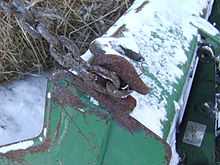
Grab hooks on the bucket are a simple and inexpensive tool and method for handling large and small round bales. This is an easy do-it-yourself modification to the tractor bucket. Two hooks are welded to the outside top of a tractor front loader bucket and a 14-foot (4.3 m) logging chain which allows the user to stay on the tractor, grab bales, transport them, stack them and place them out for animals to eat. The advantage of this simple system is that it uses no expensive equipment which must be swapped back and forth on the tractor. This method is safer than some others because the operator can stay in the tractor seat. This allows a small farmer to avoid the costs of extra equipment and not have a separate tractor just for that one function. With a little practice, one can be as quick as the specialized hydraulic bale grabs. This method, developed by Walter Jeffries of Sugar Mountain Farm, also requires less maintenance and is safer than bale spears and clamps. Using this technique bales can be easily flipped from the flat to round facing orientation (often called dinner plate vs tootsie-roll orientations). While the bale is lifted the wrap can be easily removed as well.
It is difficult to flip a round bale so that the flat surface is facing down, and later flip it back up on edge, so transporting many round bales a long distance is a challenge. Flat-bed transport is difficult since the bales could roll off the truck bed going around curves and up hills. To prevent this, the flat-bed trailer is equipped with rounded guard-rails at either end, which prevent bales from rolling either forward or backward. Another solution for this is the saddle wagon, which has closely spaced rounded saddles or support posts in which round bales sit. The tall sides of each saddle, or the bale settling down in between posts, prevent the bales from rolling around while on the wagon. On 3 September 2010, on the A381 in Halwell near Totnes, Devon, UK an early member of British rock group ELO Mike Edwards was killed when his van was crushed by a round bale. The cellist, 62, died instantly when the 600 kg bale fell from a tractor on nearby farmland before rolling onto the road and crushing his van.[8]
Round bales can be directly used for feeding animals by placing it in a feeding area, tipping it over, removing the bale wrap, and placing a protective ring (a ring feeder) around the outside so that animals don't walk on hay that has been peeled off the outer perimeter of the bale. The baler's forming and compaction process can assist in unrolling a round bale, as it is often possible to unroll a round bale in a continuous flat strip for feeding in the open, or through a feeding barrier.
Silage or haylage bales


A recent innovation in hay storage has been the development of the silage or haylage bale, which is a high-moisture bale wrapped in plastic film. These are baled much wetter than hay bales, and are usually smaller than hay bales because the greater moisture content makes them heavier and harder to handle. These bales begin to ferment almost immediately, and the metal bale spear stabbed into the core becomes very warm to the touch from the fermentation process.
Silage or haylage bales may be wrapped by placing them on a rotating bale spear mounted on the rear of a tractor. As the bale spins, a layer of plastic cling film is applied to the exterior of the bale. This roll of plastic is mounted in a sliding shuttle on a steel arm and can move parallel to the bale axis, so the operator does not need to hold up the heavy roll of plastic. The plastic layer extends over the ends of the bale to form a ring of plastic approximately 12 inches (30 cm) wide on the ends, with hay exposed in the center.
To stretch the cling-wrap plastic tightly over the bale, the tension is actively adjusted with a knob on the end of the roll, which squeezes the ends of the roll in the shuttle. In this example wrapping video, the operator is attempting to use high tension to get a flat, smooth seal on the right end. However, the tension increases too much and the plastic tears off. The operator recovers by quickly loosening the tension and allows the plastic to feed out halfway around the bale before reapplying the tension to the sheeting.
These bales are placed in a long continuous row, with each wrapped bale pressed firmly against all the other bales in the row before being set down onto the ground. The plastic wrap on the ends of each bale sticks together to seal out air and moisture, protecting the silage from the elements. The end-bales are hand-sealed with strips of cling plastic across the opening.
The airtight seal between each bale permits the row of round bales to ferment as if they were in a silo bag, but they are easier to handle than a silo bag, as they are more robust and compact. The plastic usage is relatively high, and there is no way to reuse the silage-contaminated plastic sheeting, although it can be recycled or used as a fuel source via incineration. The wrapping cost is approximately US$5 per bale.[citation needed]
An alternative form of wrapping uses the same type of bale placed on a bale wrapper, consisting of pair of rollers on a turntable mounted on the three-point linkage of a tractor. It is then spun about two axes while being wrapped in several layers of cling-wrap plastic film. This covers the ends and sides of the bale in one operation, thus sealing it separately from other bales. The bales are then moved or stacked using a special pincer attachment on the front loader of a tractor, which does not damage the film seal. They can also be moved using a standard bale spike, but this punctures the airtight seal, and the hole in the film must be repaired after each move.
Plastic-wrapped bales must be unwrapped before being fed to livestock to prevent accidental ingestion of the plastic. Like round hay bales, silage bales are usually fed using a ring feeder.
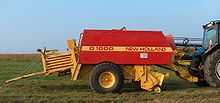
Large rectangular baler
Another type of baler in common use, in some areas, will produce large rectangular bales, each bound with a half dozen or so strings of twine, which are then knotted. Such bales are highly compacted and generally weigh somewhat more than round bales. The large rectangular bales are several times larger than the similar small bales. In the prairies of Canada, the large rectangular balers are also called "prairie raptors".
Rectangular bale handling and transport
Rectangular bales are easier to transport than round bales, since there is little risk of the bale rolling off the back of a flatbed trailer. The rectangular shape also saves space and allows a complete solid slab of hay to be stacked for transport and storage.
They are well-suited for large scale livestock feedlot operations, where many tons of feed are rationed every hour.
Due to the huge rectangular shape, large spear forks, or squeeze grips are mounted to heavy lifting machinery, such as large fork lifts, tractors equipped with front end loaders, telehandlers, hay squeezes or wheel loaders, to lift these bales.
Small rectangular baler


A type of baler that produces small rectangular (often called "square") bales was once the most prevalent form of baler, but is less common today. It is primarily used on small acreages where large equipment is impractical, and also for the production of hay for small operations, particularly horse owners who may not have access to the specialized feeding machinery used for larger baled. Each bale is about 15 in x 18 in x 40 in (40 x 45 x 100 cm). The bales are usually wrapped with two, but sometimes three, or more strands of knotted twine. The bales are light enough for one person to handle, about 45 to 60 pounds (20 to 27 kg).
To form the bale, the material to be baled, (which is often hay or straw) in the windrow is lifted by tines in the baler's pickup. This material is then dragged or augered into a chamber that runs the length of one side of the baler. A combination plunger and knife moves back and forth in the front end of this chamber. The knife, positioned just ahead of the plunger, cuts off the material at the spot where it enters the chamber from the pickup. The plunger rams the material rearwards, compressing it into the bales. A measuring device measures the amount of material that is being compressed and, at the appropriate length it triggers the mechanism (the knotter) that wraps the twine around the bale and ties it off. As the next bale is formed the tied one is driven out of the rear of the baling chamber onto the ground or onto a special wagon hooked to the rear of the baler. This process continues as long as there is material to be baled, and twine to tie it with.
This form of bale is not much used in large-scale commercial agriculture, because of the costs involved in handling many small bales. However, it enjoys some popularity in small-scale, low-mechanization agriculture and horse-keeping. Besides using simpler machinery and being easy to handle, these small bales can also be used for insulation and building materials in straw-bale construction. Square bales may generally weather better than round bales because a more much dense stack can be put up.[citation needed] However, they don't shed water as round bales do. Convenience is also a major factor in farmers deciding to continue putting up square bales, as they make feeding and bedding in confined areas (stables, barns, etc.) much easier.
Many of these older balers are still to be found on farms today, particularly in dry areas, where bales can be left outside for long periods.
The automatic-baler for small square bales took on most of its present form in 1940. It was first manufactured by the New Holland Ag and it used a small petrol engine to provide operating power. It is based on a 1937 invention for a twine-tie baler with automatic pickup.
Wire balers
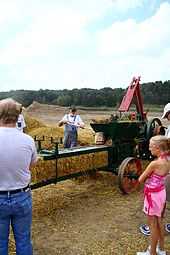
Bales prior to 1937 were manually wire-tied with two baling wires. Even earlier, the baler was a stationary implement, driven with a tractor or stationary engine using a belt on a belt pulley, with the hay being brought to the baler and fed in by hand. Later, balers were made mobile, with a 'pickup' to gather up the hay and feed it into the chamber. These often used air cooled gasoline engines mounted on the baler for power. The biggest change to this type of baler since 1940 is being powered by the tractor through its power take-off (PTO), instead of by a built-in internal combustion engine.
In present day production, small square balers can be ordered with twine knotters or wire tie knotters.
Not all stationary wire tying balers used 2 wires. It was not uncommon for the larger bale size (usually 17" x 22") machines to use 'boards' that had three slots for wires and hence tied three wires per bale. Most North American manufacturers produced these machines as either regular models or as size options. 'Small square' three wire tying pick-up balers were available from the early 1930s, principally from J. I. Case & Co. and Ann Arbor. These machines were hand tying and hand threading machines. Although New Holland credits itself with inventing the 'successful small square twine tying baler', it produced such machines for the first time in 1940 after acquiring Ed Nolte and his baler. This baler baled successfully from 1937 onwards. Certainly the quality of the New Holland machines, popularised twine tying hay balers. In Europe, in as early as 1939, both Claas of Germany and Rousseau SA of France had automatic twine tying pick-up balers. Most of these produced low density bales though. The first successful pick-up balers were made by the Ann Arbor Company in 1929. Ann Arbor were acquired by the Oliver Farm Equipment Company in 1943. Despite their head start on the rest of the field, no Ann Arbor balers carried automatic knotters or twisters. Oliver introduced these in 1949.
Square/wire bale history
Pickup and handling methods
In the 1940s most farmers would bale hay in the field with a small tractor with 20 or less horsepower, and the tied bales would be dropped onto the ground as the baler moved through the field. Another team of workers with horses and a flatbed wagon would come by and use a sharp metal hook to grab the bale and throw it up onto the wagon while an assistant stacks the bale, for transport to the barn.
A later time-saving innovation was to tow the flatbed wagon directly behind the baler, and the bale would be pushed up a ramp to a waiting attendant on the wagon. The attendant hooks the bale off the ramp and stacks it on the wagon, while waiting for the next bale to be produced.
Eventually, as tractor horsepower increased, the thrower-baler became possible, which eliminated the need for someone to stand on the wagon and pick up the finished bales. The first thrower mechanism used two fast-moving friction belts to grab finished bales and throw them at an angle up in the air onto the bale wagon. The bale wagon was modified from a flatbed into a three-sided skeleton frame open at the front, to act as a catcher's net for the thrown bales.
As tractor horsepower further increased, the next innovation of the thrower-baler was the hydraulic tossing baler. This employs a flat pan behind the bale knotter. As bales advance out the back of the baler, they are pushed onto the pan one at a time. When the bale has moved fully onto the pan, the pan suddenly pops up, pushed by a large hydraulic cylinder, and tosses the bale up into the wagon like a catapult.
The pan-thrower method puts much less stress on the bales compared to the belt-thrower. The friction belts of the belt-thrower stress the twine and knots as they grip the bale, and would occasionally cause bales to break apart in the thrower or when the bales landed in the wagon.


Bales may be picked up from the field and stacked using a self-powered machine called a bale stacker, bale wagon or harobed. There are several designs and sizes. One type picks up square bales are dropped by the baler with the strings facing upward. The stacker will drive up to each bale, pick it up and set it on a three-bale-wide table (the strings are now facing upwards). Once three bales are on the table, the table lifts up and back, causing the three bales to face strings to the side again; this happens three more times until there are 16 bales on the main table. This table will lift like the smaller one, and the bales will be up against a vertical table. The machine will hold 160 bales (ten tiers); usually there will be cross-tiers near the center to keep the stack from swaying or collapsing if any weight is applied to the top of the stack. The full load will be transported to a barn; the whole rear of the stacker will tilt upwards until it is vertical. There will be two pushers that will extend through the machine and hold the bottom of the stack from being pulled out from the stacker while it is driven out of the barn.
In Britain (if small square bales are still to be used), they are usually collected as they fall out of the baler in a bale sledge dragged behind the baler. This has four channels, controlled by automatic mechanical balances, catches and springs, which sort each bale into its place in a square eight. When the sledge is full, a catch is tripped automatically, and a door at the rear opens to leave the eight lying neatly together on the ground. These may be picked up individually and loaded by hand, or they may be picked up all eight together by a bale grab on a tractor, a special front loader consisting of many hydraulically powered downward-pointing curved spikes. The square eight will then be stacked, either on a trailer for transport, or in a roughly cubic field stack eight or ten layers high. This cube may then be transported by a large machine attached to the three-point hitch behind a tractor, which clamps the sides of the cube and lifts it bodily.
Storage methods
Before electrification occurred in rural parts of the United States in the 1940s, some small dairy farms would have tractors but not electric power. Often just one neighbor who could afford a tractor would do all the baling for surrounding farmers still using horses.
To get the bales up into the hayloft, a pulley system ran on a track along the peak of the barn's hayloft. This track also stuck a few feet out the end of the loft, with a large access door under the track. On the bottom of the pulley system was a bale spear, which is pointed on the end and has retractable retention spikes.
A flatbed wagon would pull up next to the barn underneath the end of the track, the spear lowered down to the wagon, and speared into a single bale. The pulley rope would be used to manually lift the bale up until it could enter the mow through the door, then moved along the track into the barn and finally released for manual stacking in tight rows across the floor of the loft. As the stack filled the loft, the bales would be lifted higher and higher with the pulleys until the hay was stacked all the way up to the peak.
When electricity arrived, the bale spear, pulley and track system were replaced by long motorized bale conveyors known as hay elevators. A typical elevator is an open skeletal frame, with a chain that has dull 3-inch (76 mm) spikes every few feet along the chain to grab bales and drag them along. One elevator replaced the spear track and ran the entire length of the peak of the barn. A second elevator was either installed at a 30-degree slope on the side of the barn to lift bales up to the peak elevator, or used dual front-back chains surrounding the bale to lift bales straight up the side of the barn to the peak elevator.
A bale wagon pulled up next to the lifting elevator, and a farm worker placed bales one at a time onto the angled track. Once bales arrived at the peak elevator, adjustable tipping gates along the length of the peak elevator were opened by pulling a cable from the floor of the hayloft, so that bales tipped off the elevator and dropped down to the floor in different areas of the loft. This permitted a single elevator to transport hay to one part of a loft and straw to another part.
This complete hay elevator lifting, transport, and dropping system reduced bale storage labor to a single person, who simply pulls up with a wagon, turns on the elevators and starts placing bales on it, occasionally checking to make sure that bales are falling in the right locations in the loft.
The neat stacking of bales in the loft is often sacrificed for the speed of just letting them fall and roll down the growing pile in the loft, and changing the elevator gates to fill in open areas around the loose pile. But if desired, the loose bale pile dropped by the elevator could be rearranged into orderly rows between wagon loads.
Usage once in the barn
The process of retrieving bales from a hayloft has stayed relatively unchanged from the beginning of baling. Typically workers were sent up into the loft, to climb up onto the bale stack, pull bales off the stack, and throw or roll them down the stack to the open floor of the loft. Once the bale is down on the floor, workers climb down the stack, open a cover over a bale chute in the floor of the loft, and push the bales down the chute to the livestock area of the barn.
Most barns were equipped with several chutes along the sides and in the center of the loft floor. This permitted bales to be dropped into the area where they were to be used. Hay bales would be dropped through side chutes, to be broken up and fed to the cattle. Straw bales would be dropped down the center chute, to be distributed as bedding in the livestock standing/resting areas.
Traditionally multiple bales were dropped down to the livestock floor and the twine removed by hand. After drying and being stored under tons of pressure in the haystack, most bales are tightly compacted and need to be torn apart and fluffed up for use.
One recent method of speeding up all this manual bale handling is the bale shredder, which is a large vertical drum with rotary cutting/ripping teeth at the base of the drum. The shredder is placed under the chute and several bales dropped in. A worker then pushes the shredder along the barn aisle as it rips up a bale and spews it out in a continuous fluffy stream of material.

Industrial balers
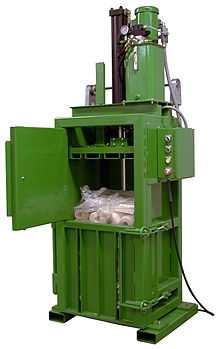
Industrial balers are typically used to compact similar types of waste, such as office paper, Corrugated fiberboard, plastic, foil and cans, for sale to recycling companies. These balers are made of steel with a hydraulic ram to compress the material loaded. Some balers are simple and labor-intensive, but are suitable for smaller volumes. Other balers are very complex and automated, and are used where large quantities of waste are handled.
See also
- List of farm implements
- Straw bale
- Beaverslide
- Paper shredder
- Glass recycling
- Paper recycling
- Plastic recycling
- Aluminium recycling
References
- ↑ 1.0 1.1 Bridon Cordage, The role of twine in North American agriculture" (accessed Jan 14, 2011)
- ↑ 2.0 2.1 2.2 http://www.ag.iastate.edu/coa150/buchele.php
- ↑ "Allis-Chalmers Innovation". Retrieved January 7, 2010.
- ↑ http://www.ag.iastate.edu/coa150/pop10_8.php
- ↑ 5.0 5.1 5.2 http://www.thefreelibrary.com/Why+the+large+round+bale%3F+A+little+hay+history.-a0128059669
- ↑ http://www.fpm.iastate.edu/maps/memorials/marker.asp?id=15-01
- ↑ "1972". Retrieved January 7, 2010.
- ↑ ELO's Mike Edwards killed by hay bale in freak crash at bbc.co.uk
External links
| Wikimedia Commons has media related to Baler. |